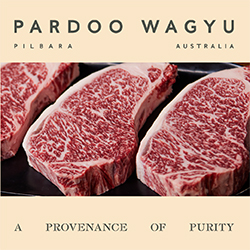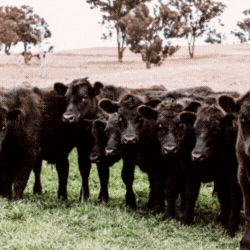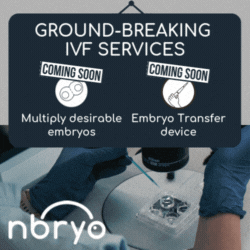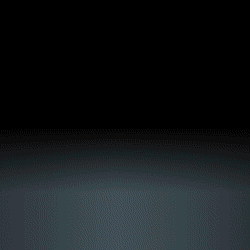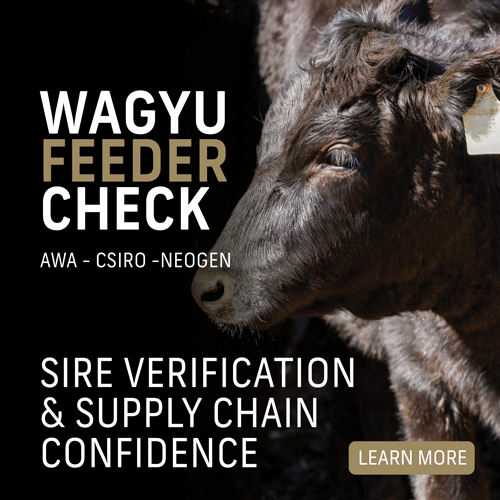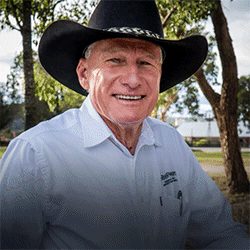Fullblood and Commercial Breeding
NEW!! - F1 Wagyu Bull Buying Guidelines
F1 Wagyu – Fullblood Bull Buying Guidelines
The standard for F1 Wagyu production is a registered Fullblood Wagyu bull with high Marble Score EBV over high-quality (high IMF%) Angus females.
Where possible, knowledge of Angus %IMF EBVs is valuable in establishing your female herd for F1 Wagyu production. The AWA F1 Wagyu – Fullblood Buy Buying guide relates to the selection of Fullblood Wagyu sires for use over high-quality Angus female genetics.
Fullblood and crossbred herds
Fullblood Wagyu production
There are two Wagyu breeds outside of Japan – Japanese Black and Red Wagyu (also known as Japanese Brown and Akaushi). Both can be registered with the AWA using DNA technology to trace animal pedigrees back to the original founder animals exported from Japan.
An animal can only be registered as a Fullblood (Japanese Black or Red) Wagyu if all forebears originate from Japan and there is no evidence of outcrossing to other breeds.
Registered Fullbloods require DNA parent verification to the sire and dam to ensure complete pedigree accuracy. A Fullblood herd consists of 100% DNA-verified Wagyu cattle.
The major black strains of Japanese Black evolved with regional geographic isolation in Japan, with distinctive performance traits identified in the most important prefectural herds. The national Japanese beef herd today comprises 95% Japanese Black cattle.
Red Wagyu (Akaushi) consist of Kochi and Kumamoto, which have been influenced by Korean and European breeds, particularly Simmental.
Utilising Wagyu BREEDPLAN will enable breeders to estimate the genetic merit of their animals and establish the pedigree of sires and dams to develop or improve a Fullblood herd.
Crossbred Wagyu production
Crossbred Wagyu herds typically use Fullblood sires with dams from other breeds, including first, second, third and fourth cross Wagyu females. Angus is the most common cross with Wagyu, due to the high availability of consistent dam lines that demonstrate low-levels of marbling.
Crossbreeding enables production of large numbers of Wagyu-content animals within a single generation.
Commercial crossbred Wagyu herds
Commercial herds are generally first and second cross Fullblood Wagyu with another breed (primarily Angus) and are more often characterised by lower marbling scores (typically MS 4-6).
Defining Wagyu content
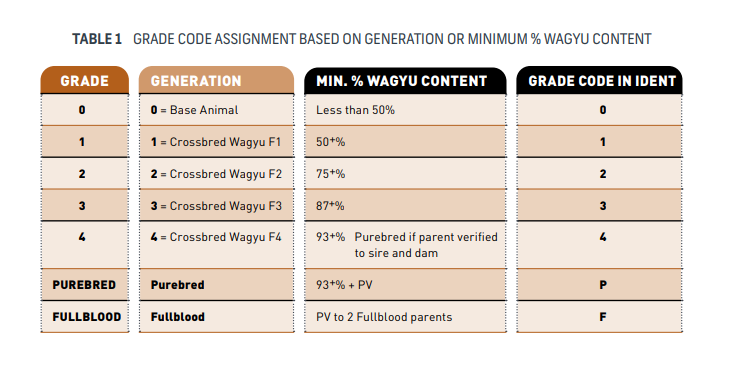
Registering animals in the Content Register can be done in 2 ways:
- Based on Parent verification results.
- If the animal can be parent verified to both parents our system will automatically calculate the grade of the animal based on the parents.
- If the animal can only be parent verified to one parent, the system will calculate the animal’s content as half the parent’s content.
- Based on Crossbred Wagyu Test (CWT) results, animals can only be registered as Grades 0 to 4.
Note – A Purebred is referred to as a crossbred animal which is parent verified to both parents and with 93+% Wagyu content.

